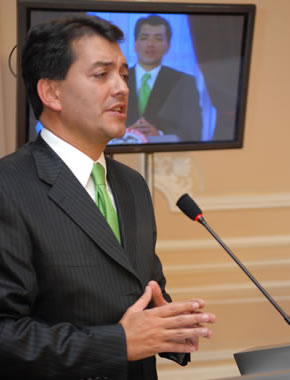Dramatic evidence presented by Colombia at last Thursday’s OAS meeting in Washington puts Hugo Chávez on the hot seat.
When Colombia launched a strike in March 2008 against a terrorist camp just over its border with Ecuador, the loudest protestation came not from Quito but from Caracas.
Venezuelan strongman Hugo Chávez mourned the death of Revolutionary Armed Forces of Colombia (FARC) commander Raúl Reyes, whom he called “a good revolutionary.” He also shrieked about the violation of Ecuadoran sovereignty and called for 10 Venezuelan tank battalions to be sent to his country’s Colombian border. “Don’t think about doing that over here,” he warned Colombian President Alvaro Uribe, “because it would be very serious, it would be cause for war.”
On Thursday, Colombia explained—albeit indirectly—why Mr. Chávez got in such a lather over that 2008 raid. In a two-hour presentation before the permanent council at the Organization of American States, Colombian OAS ambassador Luis Alfonso Hoyos laid out a series of photos, videos, maps, satellite images and computer documents that Colombia claims show the rebels using Venezuela as a safe haven much the same way they were using Ecuador.
Mr. Hoyos also charged that Venezuela knows about the guerrilla camps—some of which have been there for a long time—and has done nothing about them. Indeed, the Venezuelan National Guard sometimes consorts with the rebels, Mr. Hoyos said.
Given this new information, Mr. Chávez’s reaction to Colombia’s 2008 incursion into Ecuador now looks logical. Bogotá justified that raid on the grounds that its appeals to Quito to go after FARC taking rest and relaxation in its territory had gone nowhere. Now we know that Mr. Chávez had reason to believe he would be next.
But Mr. Uribe launched a different sort of offensive on Thursday. Instead of a military operation, he bundled new intelligence on the FARC’s Venezuelan outposts and dropped it like a bomb on the OAS permanent council.
The facts were no surprise. For years, Bogotá has been complaining—with no shortage of proof—about the friendly treatment Venezuela gives the guerrillas. But by packaging and delivering the new evidence as he did, Mr. Uribe put Mr. Chávez, very publicly, on the spot. More importantly, he has forced the issue with his hemispheric counterparts.
Mr. Hoyos told the OAS that there are some 1,500 rebels across the border in more than 75 camps. There they regroup, organize, train and prepare explosives. This safe-haven status, he explained, produces more kidnapping and drug trafficking on both sides of the border. And more carnage in Colombia: Graphic photos of rebel victims flashed on a screen while he spoke.
Mr. Hoyos did not call for sanctions against Venezuela. Instead he asked for an international commission to verify Colombia’s claims. He promised that his government could provide the “precise coordinates” of farms and haciendas where the rebels are ensconced. “If what is there is only a little school and humble peasants, there would be no problem with an international commission to verify if Colombia’s accusation is not true,” Mr. Hoyos argued.
That sounds reasonable enough. But the OAS meeting was not even over when Mr. Chávez, unable to contain his frustration at being embarrassed again in the political arena by Mr. Uribe, broke diplomatic relations with Colombia. It was, he explained, the right thing to do for “dignity.” Sadly for Venezuelans, though, any dignity their government may have once possessed checked out a long time ago. Colombia’s data dump was just the latest humiliation that Mr. Chávez’s credibility has suffered on the world stage.
Yet despite what seemed like great chavistaumbrage, it’s likely Venezuela and its allies around the region saw it all coming. On Wednesday, Ecuador’s OAS ambassador, who was holding the rotating presidency of the permanent council, resigned. He said he had to because he was not able to deliver on his government’s request to block Colombia’s presentation. Ecuadoran foreign minister Ricardo Patiño, a close ally of Venezuela who is apparently wholly unfamiliar with the notion of institutional rules, spent Friday chastising OAS Secretary General José Miguel Insulza for allowing Colombia to invoke its OAS right to make its case.
The U.S. State Department said Mr. Chávez’s decision to break with Colombia was petulant and happily it also said that it would “endorse Colombia’s proposals.” This will help the chances for a verification committee at the OAS. It also explains why Ecuador and Argentina have both expressed interest in taking the matter to the South American multilateral forum known as Unasur, where Mr. Uribe will be outnumbered by leftist tyrants.
Even if the OAS verification committee does not come to fruition, Colombia is not without options. It could ask the U.N. Security Council to invoke Resolution 1373, which prohibits members from harboring or helping terrorists. And last week Colombia’s attorney general suggested the matter could go to the Hague’s International Criminal Court.
The pro-Chávez crowd is now feigning concern about war. But if Venezuela is giving the FARC safe haven, it is already engaged in aggression against its neighbor. That’s an inconvenient truth that is hard to dodge.
Source: Wall Street Journal












[…] Terrororganisation FARC mit mehr als guten Worten unterstützt, dafür mehren sich die Anzeichen, berichtet Mary […]